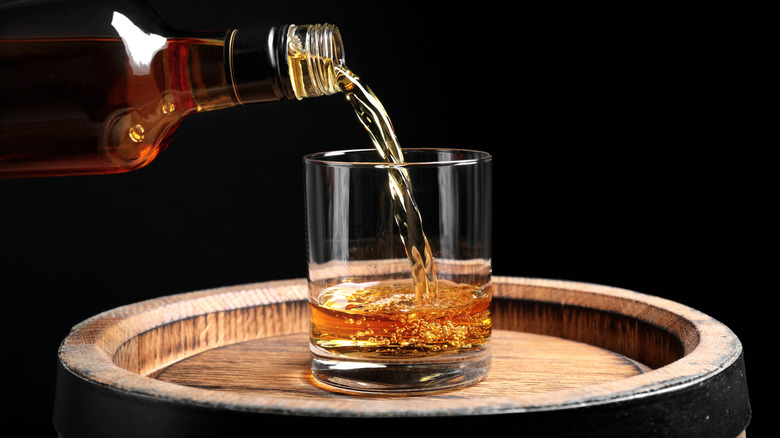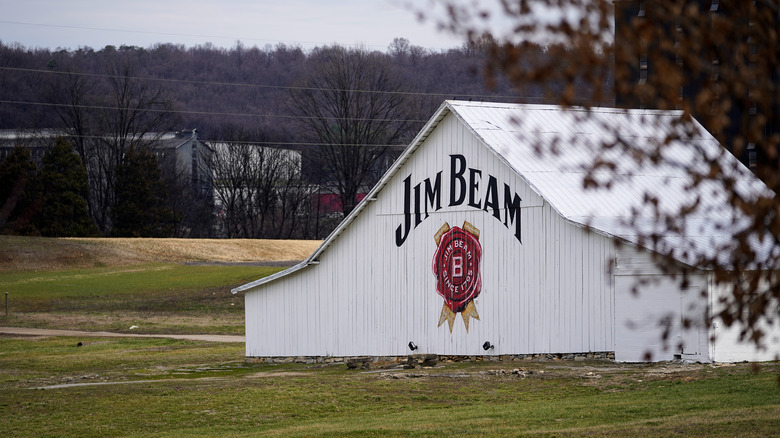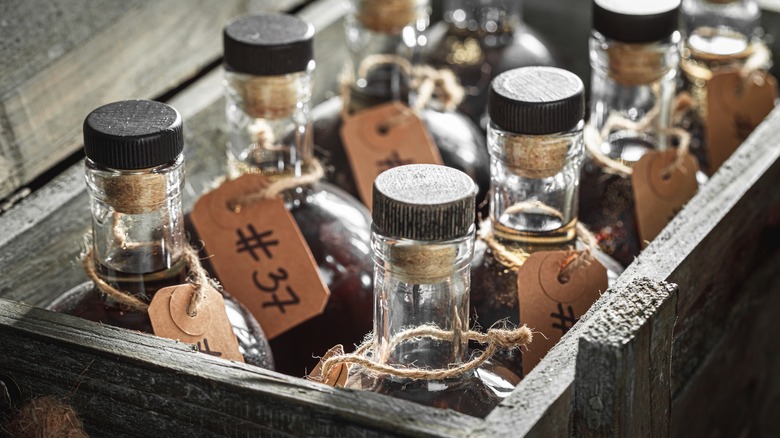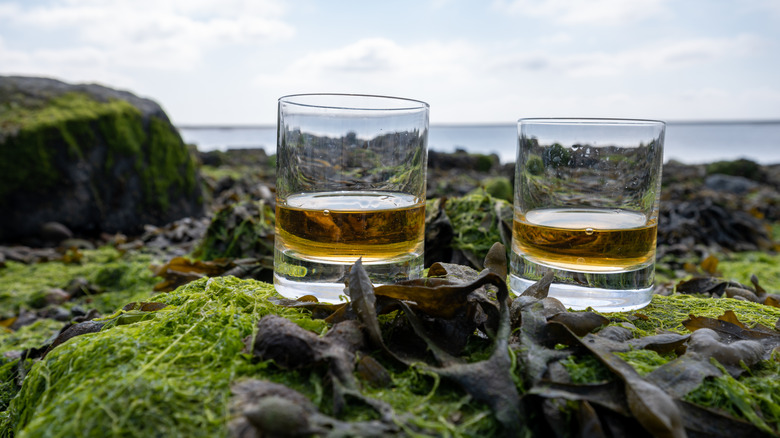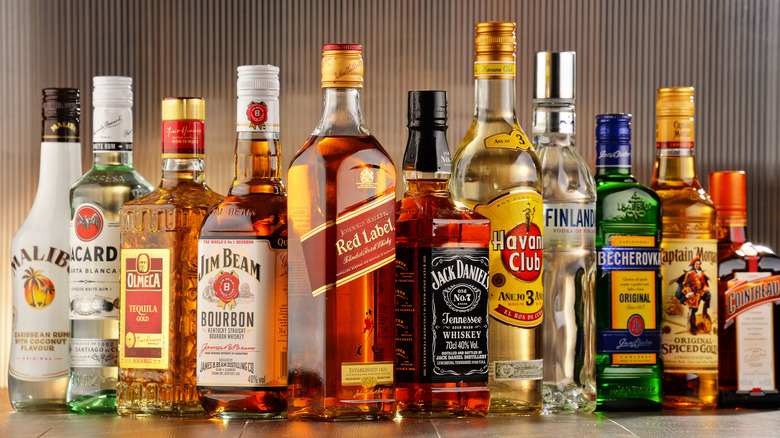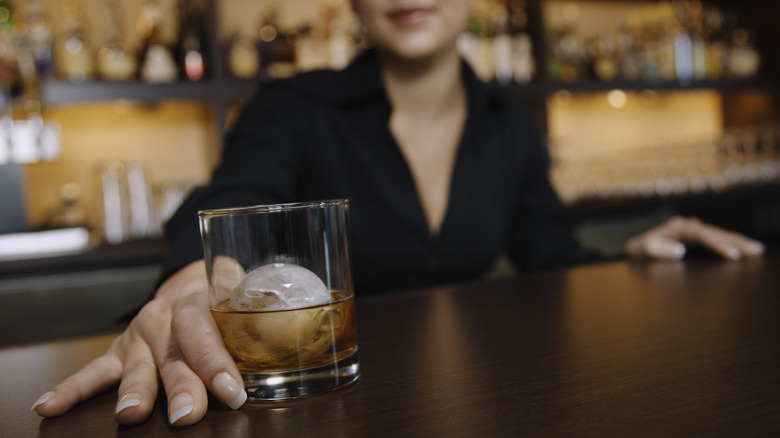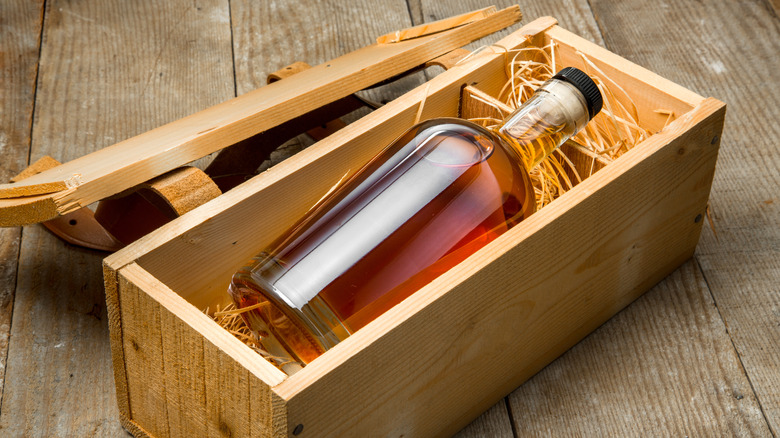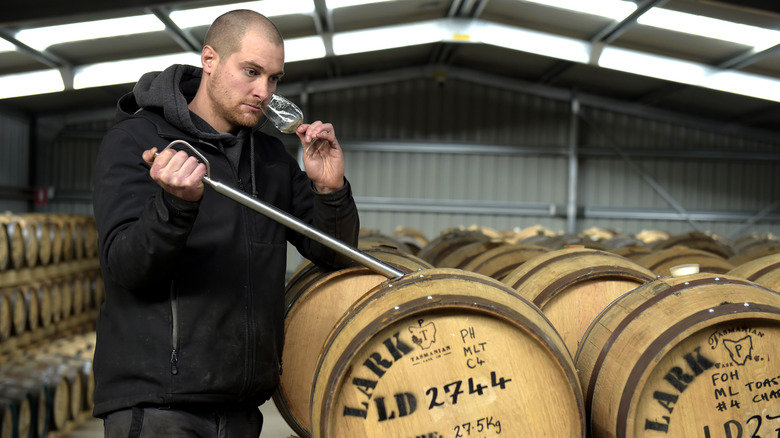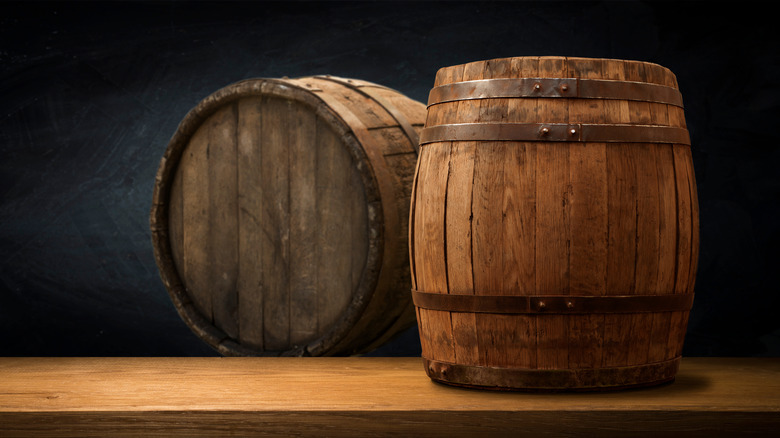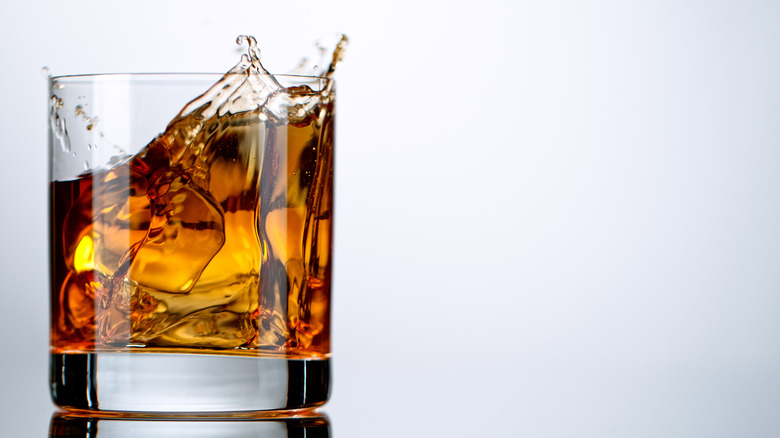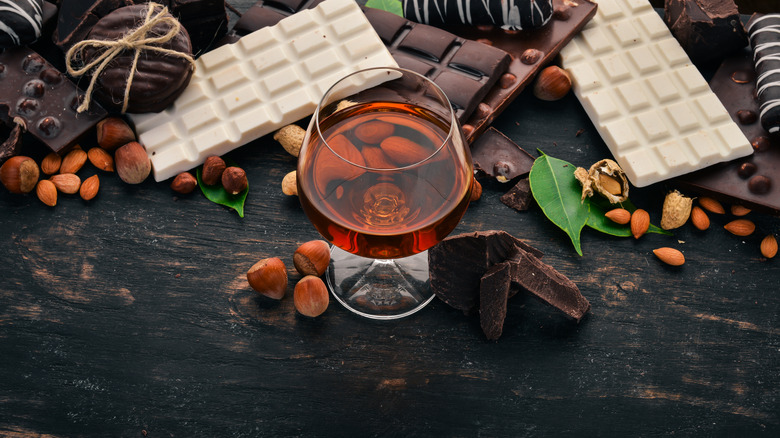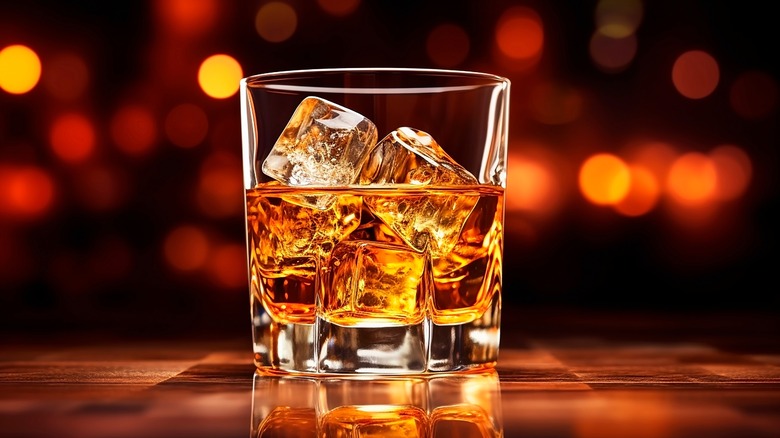11 Bourbon Myths Debunked
Americans are drinking more bourbon than ever before, with sales of American whiskey soaring in 2023 — over 31 million cases sold throughout the U.S., marking an increase of 132% since 2003, and earning distillers almost $5.3 billion (via Distilled Spirits Council of the United States). This bourbon resurgence has sparked interest in traditional distilling techniques and spawned several myths surrounding its production, taste, and heritage.
With its warm, amber color and complex flavors, this classic drink is a favorite among drinkers globally, and the myths swirling around it are as intricate as the spirit itself. Many of these myths intertwine fact with half-truths, ranging from the belief that all bourbon must hail from Kentucky to the notion that age solely determines its quality. Other myths perpetuate misconceptions about the legal requirements for its production or the effect of the barrel on its flavor.
There's also a romanticized narrative that only the oldest distilleries can produce top-tier bourbon, overlooking the innovative craftsmanship of newer players in the market. So, before taking another sip of bourbon, let's fully appreciate the drink and unravel these tales. We'll dismantle the most entrenched bourbon myths, allowing for a deeper understanding and appreciation of this beloved drink. We also hope to challenge your preconceptions and enrich your bourbon knowledge as we explore the heart of these myths, revealing the distilled truth.
1. Myth: All bourbon comes from Kentucky
You've probably heard that all bourbon must originate in Kentucky — a notion as inseparable as peanut butter and jelly. Although the Bluegrass State rightly earns its bourbon crown (we'll get to that later), this pervasive myth misses the mark by a barrel length, underscoring why such a belief is so prevalent.
Indeed, Kentucky is considered the traditional heartland of bourbon, where a unique blend of climate, water, and tradition converge. Home to legendary bourbon distilleries, including famous ones like Maker's Mark and Jim Beam, the state crafts nearly 95% of the world's bourbon. These facts lend credence to the belief that only bourbon produced in Kentucky can bear the name. Unfortunately, this belief is false. In reality, bourbon can be distilled anywhere in the U.S., provided it meets specific legal guidelines. Its geographical location within the country isn't one of them.
The federal Standards of Identity for Distilled Spirits specify that bourbon must be crafted from a mash of at least 51% fermented grain and aged in new, charred oak barrels. It must also be distilled at no more than 160 proof, stored at no more than 125 proof for aging, and produced in the U.S. to earn the "bourbon" label. While Kentucky may be the bourbon capital, the spirit of bourbon production is alive and well across the United States, embracing diverse flavors and rich traditions.
2. Myth: Bourbon must be aged for many years to be good
This myth might have you picturing barrels of bourbon stored away for decades, slowly and magically morphing into liquid gold. While age plays a role in developing bourbon's distinctive flavors and richness, it's not the sole determinant of the spirit's quality. Aging bourbon in new, charred oak barrels gives it a richer flavor, color, and smoother texture — leading some to equate age with quality and automatic richness.
The truth? Bourbon's quality depends on more than aging; it's also about the distillation process, the barrels' integrity, and the aging conditions. Some types of bourbon achieve exceptional quality in fewer years, defying the notion that over-aging is necessary for superior taste. It's important to note that legal regulations require straight bourbon whiskey to age at least two years and "bottled-in-bond" bourbon at least four years, but this doesn't necessarily mean that over-aging is a must for excellence.
Bourbon can achieve its unique character in shorter aging periods with careful attention to distillation, grain recipes, barrel types, and storage conditions. As the spirit interacts with the charred barrel, the temperature fluctuations, and the oak's quality, a more decadent bourbon can be created without needing it to sit longer in the barrel. So, the myth that bourbon must be aged for many years to be good is just that — a myth. Bourbon's quality lies in its craftsmanship, not its age.
3. Myth: Bourbon and whiskey are the same
Have you ever ordered whiskey expecting a smooth bourbon? It's technically true that all bourbon is whiskey, but not all whiskey is bourbon. Bourbon's amber hues and the different types of whiskeys can easily create confusion, especially among casual drinkers. This confusion is understandable, given that bourbon boasts a strong presence in the whiskey world, leading some to use the terms interchangeably.
The truth is that both spirits share a common ancestor — fermented grain mash, which can include barley, corn, rye, and wheat. Whiskey's characteristics depend on the grains used, distillation, and the aging process. On the other hand, bourbon, an American whiskey, has a specific recipe and aging process. By law, bourbon must be made in the U.S., contain at least 51% corn in its grain mash, and be aged in new charred oak barrels. These specific requirements give bourbon its distinctive taste.
The high corn content in bourbon's mash bill lends a sweeter taste not found in other whiskeys. For instance, rye whiskey is known for its spicier kick. Also, aging bourbon in new, charred oak barrels infuses it with vanilla notes and hints of toffee, honey, or brown sugar, thanks to the caramelization of wood sugars. Understanding these nuances is crucial for appreciating the whiskey's uniqueness. The next time you reach for a glass, remember — it might be whiskey, but it could also be uniquely bourbon whiskey.
4. Myth: High price equals high quality
This pervasive myth might have you reaching for your wallet instead of relying on your taste buds. It's a common belief that expensive often equals better — a notion that applies broadly from gadgets to garments. With bourbon, a hefty price tag coupled with the allure of prestige from limited edition bottles, rare age statements, and fancy packaging amplify this misconception.
However, bourbon's reality paints a different picture. Quality bourbon is available at every price point with many affordable options (priced under $30) offering an exceptional taste that rivals their pricier counterparts. Consider Henry McKenna 10, for example; it's celebrated for its excellent quality at a modest price. In contrast, some high-ticket bourbons, like Van Winkle Special Reserve "Lot B" 12, may not always meet their lofty expectations compared to more budget-friendly options like Weller 12. Since taste is subjective, your perfect bourbon pour might be hiding in a humble bottle waiting to be discovered.
Ultimately, bourbon's quality depends on the aging process, distillation techniques, and the blend of ingredients. The craftsmanship and distiller's skill dictate a bourbon's value. Bourbons exist across all price ranges, from the readily available Four Roses store picks to the more exclusive, high-end labels. The key is to explore, taste, and find what truly resonates with you rather than relying on the price tag alone.
5. Myth: Bourbon can only be enjoyed neat
Purists often argue that drinking bourbon unadulterated (with no additions) best reveals its depth and complexity. Yet, the notion that sipping neat is the only way to enjoy this premium spirit is an age-old myth. These folks claim that mixing anything with American whiskey masks its unique flavors and aromas, ranging from sweet vanilla and caramel to oak and spicy notes.
Sadly, this narrow view unfairly limits bourbon's potential as a cocktail ingredient. Its natural sweetness, from a corn-rich mash, perfectly complements various mixers. Far from overshadowing the bourbon, these pairings often unlock new taste dimensions rather than mask them. Take, for example, classic cocktails like the Mint Julep and the old fashioned. These drinks, designed for leisurely sipping, gain a rich, sophisticated depth from bourbon, enhancing the drinking experience.
In a Mint Julep, bourbon's smooth, sweet profile cuts through the mint's fresh sharpness, while in an old fashioned, it blends with bitters and sugar to offer a rich, complex taste. These examples merely scratch the surface; bourbon's robust nature pairs well with numerous ingredients, inviting mixology enthusiasts to explore. So, whether you prefer it neat, on the rocks, diluted, or in a cocktail, bourbon offers a wide range of enjoyment, transcending the purist's narrow (equally sad) viewpoint.
6. Myth: Bourbon can age itself in the bottle
No matter how long your dusty bottle of bourbon sits on a shelf, it won't taste better with age. Sure, the age statement on the label — referring to the duration bourbon spends in barrels — might suggest that the more time it spends bottled, the more flavorful it gets. But that's not the case. Bourbon stops developing deeper flavors once it leaves the barrel.
The idea that bourbon can age itself in the bottle stems from the aging process in oak barrels. While in the barrel, bourbon gains complexity and nuances from interacting with charred wood. The spirit absorbs flavors from the oak and undergoes chemical reactions influenced by changes in temperature and exposure to oxygen, which contribute to its rich taste and aroma. Unfortunately, this process halts the moment bourbon is transferred from the barrel to the bottle.
The reason? Sealed bottles lack the dynamic conditions found in barrels. There's no interaction with wood, no temperature fluctuation, and no oxygen exchange. Essentially, what you taste at the time of bottling is what you get; the bourbon's character remains unchanged over time, regardless of how long it sits on a shelf. So, storing a bottle of bourbon, even for decades, won't enhance its taste. While certain bottles may become more valuable as collectibles due to rarity or age, the contents inside won't improve with time. With bourbon, the magic happens inside the barrel, not the bottle.
7. Myth: Bourbon must have a high proof to be good
Every whiskey lover nearly succumbs to the myth that higher-proof bourbon is inherently superior, boasting more flavor and offering a "truer" experience. This assumption leans on the idea that higher alcohol content translates to a more authentic and flavorful bourbon experience. Given bourbon's regulated proof range — from the required minimum of 80 proof (40% alcohol by volume or ABV) to a traditional benchmark of around 100 proof — this myth implies that anything on the higher end of this spectrum is better.
For the record, high proof doesn't necessarily mean a top-tier bourbon. Of course, bourbons bottled at higher proofs undergo less dilution, offering a more concentrated flavor and a stronger kick. However, the quality of the bourbon depends on its craftsmanship (not alcohol content) as well as the grain quality, distillation process, aging conditions, and the skill of the master distiller.
A high-quality bourbon can indeed come at higher proofs, providing a robust experience for those who savor the intensity. Yet, many exceptional bourbons are bottled at lower proofs, featuring complex, nuanced flavors that appeal to a broader range of palates. So, don't let proof be the sole guide in choosing your bourbon. Instead, take the time to explore and taste different bourbons to discover the one that resonates with your palate. The real measure of bourbon's worth lies in the art and skill of its crafting, not merely in the strength it packs.
8. Myth: Single batch means single barrel
The belief that "single batch" bourbon means "single barrel" often confuses many bourbon enthusiasts. It's understandable why this confusion exists since both terms imply a level of exclusivity and a unique tasting experience. This misunderstanding likely stems from the close association between terms like "single" and "batch" or "barrel," which suggest a singular origin. But this isn't exactly the case.
Single-barrel bourbon comes from one individual barrel, creating a distinct taste and character that can vary significantly from barrel to barrel. This variation is due to the unique conditions each barrel experiences, such as its location in the warehouse, that affect its aging process. On the other hand, "single batch" bourbon refers to bourbon distilled and processed in one batch but may blend whiskeys from multiple barrels. This blending aims for a consistent flavor profile across bottles, contrasting the variability expected with single-barrel offerings.
So, to dispel any confusion, a single batch doesn't mean a single barrel. Single-barrel bourbons celebrate the unique characteristics that each barrel imparts, while single-batch bourbons focus on consistency and uniformity in flavor, blending spirits from different barrels to achieve this goal.
9. Myth: Bourbon colors are enhanced
This "truth" that bourbon's deep amber color is artificially enhanced gets tossed around a lot. Indeed, bourbon's warm colors hold undeniable allure, but judging this spirit's quality solely by shade is like picking a book based on its cover — it's misleading and inaccurate. This bourbon myth stems from general skepticism toward food and drink processing practices, where artificial additives are often used for aesthetic purposes.
But this couldn't be further from the truth for bourbon. The characteristic golden brown hue of bourbon comes naturally from its aging process in charred white oak barrels. These barrels are essential not merely for color but also for flavor. In fact, the interaction with the charred wood is responsible for all of its coloring and nearly two thirds of its flavor profile.
Some bourbons go through an extra step by aging in retired sherry or amontillado barrels, which adds unique, subtle flavoring notes. These practices highlight the natural processes behind bourbon's color and taste, debunking the myth of artificial enhancement. Bourbon's color is a direct testament to its aging process and the careful craftsmanship that goes into producing each bottle. So, next time you enjoy a glass of bourbon, remember that its rich color is as authentic as its taste.
10. Myth: Flavored bourbon isn't real bourbon
Ever hear someone quip, "that ain't true bourbon" around a glass of chocolate-infused whiskey? Many bourbon enthusiasts argue that flavored bourbon shouldn't be considered "real" bourbon. They believe the long-standing tradition that bourbon, a uniquely American whiskey, must adhere to strict production rules — a composition of at least 51% corn, aged in new, charred oak barrels, and without flavor or color additives. Given these criteria, purists may look down on flavored variations as less authentic.
However, under scrutiny, this perspective falters. The truth is that flavored bourbon is a bourbon variant with a twist. These distilled spirits begin as genuine bourbon, following all the traditional guidelines. The flavoring, which occurs after the aging process, simply adds a new dimension and broadens its appeal. Flavors that range from honey to cinnamon may enhance rather than diminish the bourbon's identity. They build upon its foundation.
Understanding this, it's absolutely clear that flavored bourbon shouldn't be disregarded as inauthentic. Instead, it represents an evolution of the bourbon category, offering beginners an inviting bridge and connoisseurs a flavorful detour. Flavored bourbon remains rooted in tradition, with a modern twist that respects its heritage while embracing innovation.
11. Myth: Water and ice ruin bourbon
Raise your glass if people have ever scoffed at your ice-filled glass of bourbon! It's a common myth, swirling as persistently as the cubes themselves, that adding water or ice to bourbon dilutes its very essence, complexity, and depth. However, like a well-aged barrel, this age-old myth harbors far more misconceptions than truth.
The truth of the matter is that water acts as bourbon's silent partner in crime; adding drops of this precious liquid to bourbon actually enhances its flavors. During the aging process in barrels, the water molecules, being smaller than ethanol, penetrate the wood more effectively, drawing out desirable charred flavors. So, when added to a glass of bourbon, the water interacts with the spirit, potentially releasing new flavors and aromas that were previously dormant. High-quality, slow-melting ice also offers a similar, refreshing twist. It cools the bourbon, making it more palatable for some while also slightly diluting the spirit as it melts. Ice simply softens harsher notes, especially in higher-proof bourbons, making them more approachable.
Interestingly, the science of distillation supports this. Bourbons with lower entry proofs, which contain more water before entering the barrel, extract more desirable flavors during the aging process. Consequently, less water needs to be added to them later to reach the standard 80-100 proof of most spirits. So, rather than ruining bourbon, water and slow-melting ice actually give you a more nuanced drinking experience.
